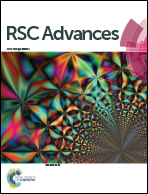Electrochemical sulfonylation of alkenes with sulfonyl hydrazides: a metal- and oxidant-free protocol for the synthesis of (E)-vinyl sulfones in water†
Abstract
An efficient electrochemical transformation of a variety of alkenes and sulfonyl hydrazides into vinyl sulfones with a catalytic amount of tetrabutylammonium iodide in water is reported. The reaction proceeds smoothly to afford vinyl sulfones with good selectivities and yields at room temperature under air in an undivided cell. Cyclic voltammograms and control experiments have been performed to provide preliminary insight into the reaction mechanism. The key features of this reaction include using pure water as solvent, transition metal- and oxidant-free conditions, and being easily scaled up to gram-scale synthesis.



 Please wait while we load your content...
Please wait while we load your content...